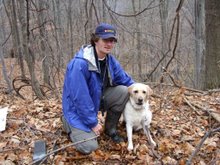Canoeing II - I dunked!
Last night I went down to the Ottawa River for the second part of my canoeing course. It would be the practical, on-water portion. For some reason, I decided to come prepared, I had wired my keys into my shorts, dressed in quick dry clothing and added a polar fleece vest. I decided to leave anything of value at home and to zip all my pockets shut. Before we headed out on the water I asked Tim if he could take some pictures throughout the lesson to document the adventure.
As promised, I took pictures of the two types of canoes that we would use, the quetico canoe sits lower in the water than the prospector. The prospector has a more pronounced rocker (front of the canoe) allowing it to carry heavier loads but is less stable when not weighted down. Here we see the first party getting ready to embark. While on the water, Tim explained that when you are paddling you are doing one of two motions pulling water (forward stroke) or pushing it (back stroke). The other strokes are known as corrective strokes. He demonstrated the “J” stroke, the draw (moving the paddle parallel to the canoe, drawing toward the side of the canoe), prying (moving the paddle parallel to the canoe, but pushing water away from the side of the canoe). It was time to try out these strokes. I should say first off, that it was Roger’s first time in the canoe and he was in the stern (back). We headed out onto the river and had fun paddling in circles for a while before we sorted our strokes out. I was a little nervous as the Ottawa River has a strong current and Roger wasn’t too concerned that we getting caught in the current leading towards the power dam. It took some aggressive paddling to get us back into the lee of the bay. After paddling around we headed into shore to change positions. I would be in the stern of the canoe. I careful working along the length of canoe and gently sat down in the canoe. When the canoe is partly on shore and it in the water it is unstable. As Roger got into the canoe backward and pushed used off shore somehow how is weight shifted. The canoe capsized. We were close to shore. The water waist deep but the experience was a little unsettling.
We paddled for about an hour and did a stroke drills by paddling around triangle . This was fun but at the same time a little challenging as Roger wanted to constantly flip his paddle to either side of the canoe every minute. Using the forward stroke, the J-stroke and the pry stroke, I was able to sight a couple of landmarks and get a hang of paddling in a straight line. This is an art. After a while you sort of become one with the canoe and get a feel how it responds to certain actions. Most of the motions are gradual. It was time to let Roger take the stern again. We headed out from port without event. I explained to Roger that if we wanted to head right, to use the J stroke and to head left, he would have to do a pry stroke. He started to get the knack of the stroke and we were able to head in a straight line to towards some trees on shore. Roger decided that we be a little more aggressive with the canoe. As we were heading through a confluence in the river he tried an aggressive J stroke. It didn’t go well, as moments later, we were both in the water. The Ottawa River was cold. In the nick of time, I grabbed my hat but wasn’t so lucky with my sunglasses. We were able to swim with the canoe towards another one nearby and to do a on-the-water canoe rescue. This involves pushing the upended canoe across the center point of another canoe. We hauled ourselves back into the canoe. For more reason, I packed my normal glasses in my vest and was able to see again. We paddled toward shore and emptied the canoe and to catch our breath and dry out a bit. At this point, there was an hour left in the lesson so Roger and I worked on canoe drills close to shore.
- Chris and his paddle.
- Chris in the shadows

|